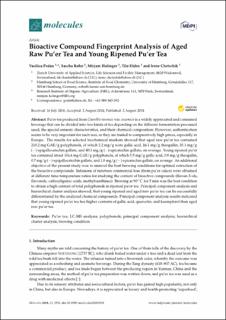Please use this identifier to cite or link to this item:
https://doi.org/10.21256/zhaw-3963Full metadata record
| DC Field | Value | Language |
|---|---|---|
| dc.contributor.author | Pedan, Vasilisa | - |
| dc.contributor.author | Rohn, Sascha | - |
| dc.contributor.author | Holinger, Mirjam | - |
| dc.contributor.author | Hühn, Tilo | - |
| dc.contributor.author | Chetschik, Irene | - |
| dc.date.accessioned | 2018-08-30T09:05:44Z | - |
| dc.date.available | 2018-08-30T09:05:44Z | - |
| dc.date.issued | 2018-08-02 | - |
| dc.identifier.issn | 1420-3049 | de_CH |
| dc.identifier.issn | 1433-1373 | de_CH |
| dc.identifier.uri | https://digitalcollection.zhaw.ch/handle/11475/9970 | - |
| dc.description.abstract | Pu'er tea produced from Camellia sinensis var. assamica is a widely appreciated and consumed beverage that can be divided into two kinds of tea depending on the different fermentation processed used, the special sensory characteristics, and their chemical composition. However, authentication seems to be very important for such teas, as they are traded to comparatively high prices, especially in Europe. The results for selected biochemical markers showed that aged raw pu'er tea contained 210.2 mg GAE/g polyphenols, of which 2.2 mg/g were gallic acid, 16.1 mg/g theogallin, 35.1 mg/g (-)-epigallocatechin gallate, and 40.1 mg/g (-)-epicatechin gallate, on average. Young ripened pu'er tea contained about 104.6 mg GAE/g polyphenols, of which 5.5 mg/g gallic acid, 0.9 mg/g theogallin, 0.7 mg/g (-)-epigallocatechin gallate, and 1.8 mg/g (-)-epicatechin gallate, on average. An additional objective of the present study was to unravel the best brewing conditions for optimal extraction of the bioactive compounds. Infusions of nineteen commercial teas (from pu'er cakes) were obtained at different time-temperature ratios for studying the content of bioactive compounds (flavan-3-ols, flavonols, caffeoylquinic acids, methylxanthines). Brewing at 90°C for 5 min was the best condition to obtain a high content of total polyphenols in ripened pu'er tea. Principal component analysis and hierarchical cluster analysis showed, that young ripened and aged raw pu'er tea can be successfully differentiated by the analyzed chemical compounds. Principal component analysis results indicated that young ripened pu'er tea has higher contents of gallic acid, quercetin, and kaempferol than aged raw pu'er tea. | de_CH |
| dc.language.iso | en | de_CH |
| dc.publisher | MDPI | de_CH |
| dc.relation.ispartof | Molecules | de_CH |
| dc.rights | http://creativecommons.org/licenses/by/4.0/ | de_CH |
| dc.subject | LC-MS analysis | de_CH |
| dc.subject | Pu’er tea | de_CH |
| dc.subject | Brewing condition | de_CH |
| dc.subject | Hierarchical cluster analysis | de_CH |
| dc.subject | Polyphenols | de_CH |
| dc.subject | Principal component analysis | de_CH |
| dc.subject.ddc | 663: Getränketechnologie | de_CH |
| dc.title | Bioactive compound fingerprint analysis of aged raw pu’er tea and young ripened pu’er tea | de_CH |
| dc.type | Beitrag in wissenschaftlicher Zeitschrift | de_CH |
| dcterms.type | Text | de_CH |
| zhaw.departement | Life Sciences und Facility Management | de_CH |
| zhaw.organisationalunit | Institut für Lebensmittel- und Getränkeinnovation (ILGI) | de_CH |
| dc.identifier.doi | 10.21256/zhaw-3963 | - |
| dc.identifier.doi | 10.3390/molecules23081931 | de_CH |
| dc.identifier.pmid | 30072634 | de_CH |
| zhaw.funding.eu | No | de_CH |
| zhaw.issue | 8 | de_CH |
| zhaw.originated.zhaw | Yes | de_CH |
| zhaw.publication.status | publishedVersion | de_CH |
| zhaw.volume | 23 | de_CH |
| zhaw.publication.review | Peer review (Publikation) | de_CH |
| zhaw.webfeed | LM-Chemie | de_CH |
| Appears in collections: | Publikationen Life Sciences und Facility Management | |
Files in This Item:
| File | Description | Size | Format | |
|---|---|---|---|---|
| Pedan_2018.pdf | 953.39 kB | Adobe PDF |  View/Open |
Show simple item record
Pedan, V., Rohn, S., Holinger, M., Hühn, T., & Chetschik, I. (2018). Bioactive compound fingerprint analysis of aged raw pu’er tea and young ripened pu’er tea. Molecules, 23(8). https://doi.org/10.21256/zhaw-3963
Pedan, V. et al. (2018) ‘Bioactive compound fingerprint analysis of aged raw pu’er tea and young ripened pu’er tea’, Molecules, 23(8). Available at: https://doi.org/10.21256/zhaw-3963.
V. Pedan, S. Rohn, M. Holinger, T. Hühn, and I. Chetschik, “Bioactive compound fingerprint analysis of aged raw pu’er tea and young ripened pu’er tea,” Molecules, vol. 23, no. 8, Aug. 2018, doi: 10.21256/zhaw-3963.
PEDAN, Vasilisa, Sascha ROHN, Mirjam HOLINGER, Tilo HÜHN und Irene CHETSCHIK, 2018. Bioactive compound fingerprint analysis of aged raw pu’er tea and young ripened pu’er tea. Molecules. 2 August 2018. Bd. 23, Nr. 8. DOI 10.21256/zhaw-3963
Pedan, Vasilisa, Sascha Rohn, Mirjam Holinger, Tilo Hühn, and Irene Chetschik. 2018. “Bioactive Compound Fingerprint Analysis of Aged Raw Pu’er Tea and Young Ripened Pu’er Tea.” Molecules 23 (8). https://doi.org/10.21256/zhaw-3963.
Pedan, Vasilisa, et al. “Bioactive Compound Fingerprint Analysis of Aged Raw Pu’er Tea and Young Ripened Pu’er Tea.” Molecules, vol. 23, no. 8, Aug. 2018, https://doi.org/10.21256/zhaw-3963.
Items in DSpace are protected by copyright, with all rights reserved, unless otherwise indicated.